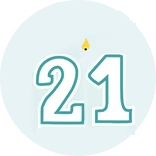Your 20-Month-Old’s Development and Milestones
At 20 months old, your mobile, active toddler will be walking and in the mood to play and explore. You’ll never be bored with a toddler in the house, and when they are 20 months old, life will be an adventure not just for them but for you as well. Learn all about some of the challenges and the exciting things in store for you and your little one this month.
Toddler Development Milestones
You’ll notice your toddler can do more and more each month, and this month is no exception. Although each child develops at their own pace, you may notice the following things at 20 months old:
Separation anxiety may start easing. Your 20-month-old may feel anxious from time to time when you leave the room or your home. If this happens, give them a quick kiss and a hug, and tell them you’ll be back soon. The good news is that separation anxiety is only temporary, and chances are it’ll start to taper off soon.
Walking progress. Around this time, your toddler will likely become more skilled and confident at walking. You may notice that they have a more mature gait and that they may not be using their hands for balance anymore. They might even walk moving their feet from heel to toe. Before long, you’ll see some short, stiff runs.
Acting impulsively. Toddlers may act impulsively and at this age have little idea of right and wrong or that actions have consequences. It’s up to you to help your child learn this in the months and years ahead, but right now, your priority is to be extra vigilant, ready to redirect your little one’s attention from anything dangerous to something safe. For example, if they’re about to reach for a breakable object, swoop in and give them a safe object to play with instead. With firm but gentle guidance and through setting consistent boundaries, over time you can help your little one understand right from wrong, safe from unsafe, and help them get better at self-discipline.
Activities for Supporting Your 20-Month-Old Toddler’s Development
Encourage your little one learn and grow with these ideas that help foster your 20-month-old toddler’s physical, mental, and emotional development:
Funnel their energy into play and movement. Your toddler has a lot of energy, and occasionally, when they’re frustrated or upset, they may act up. By channeling this pent-up energy into things like running around outside or playing with a ball, you may be able to avoid some of those shows of aggression.
Catch them being good. Noticing and praising your 20-month-old for good behavior is one of the most effective tools you have for managing tantrums and other behavioral problems. Your child wants and needs your approval and attention, so make a point of being enthusiastic (without going overboard) when they do something right. You can offer a verbal compliment or even a quick hug to let them know that you’re proud of them.
Let them figure things out. Playing at this age means exploring and trying things out, and it’s fascinating to watch your toddler grapple with what does and doesn’t work. For example, you may see them trying to push a toy truck through a space that’s too small or experimenting to see which objects will fit into a container. Let them figure it out at their own pace. If they’re attempting to build something with blocks or make piles according to shape, you might help them by asking “Does that block have square or round edges?”
Create holiday traditions and family rituals. Seasonal holidays are great fun to celebrate with a young child, especially when they have an important role to play. At Halloween, they can help make and put up spooky decorations, or draw a face for you to carve on a pumpkin. For the Fourth of July, you can put up a flag together, and they can help with making a red, white, and blue dessert. Look at any holidays celebrated by your family as opportunities to create your own routines, rituals, and traditions.
Mealtimes and Menus for Your 20-Month-Old
As your growing toddler needs a variety of nutritious foods to keep them healthy and strong, offering three small meals and two snacks a day is a good plan. These toddler breakfast ideas and lunch ideas can help you plan. Make sure your child gets enough protein, dairy, whole grains, fruits, and vegetables, which can be spread out across meals.
Serve nutritious foods to your little one and let them choose what they want. Your toddler’s diet will balance out over several days if you offer a range of healthy choices, so don’t worry if you don’t get every food group in at each meal.
Getting Your Toddler Into Veggies
If you’re struggling to get your little one to eat their greens, here are a few tricks you can try:
Eat veggies yourself. Your little one looks up to you as a role model, so if they see you eating your vegetables, they’re more likely to try it for themselves.
Add variety. Offering veggies of different colors, shapes, and textures can make them more fun for your toddler. Perhaps your little one likes mashed potatoes; you could substitute mashed cauliflower occasionally. Or you can mix the veggies with something else, such as broccoli with cheese.
Try dips and sauces. Get your toddler to like veggies by serving them with a tasty sauce or a dip to make the vegetables more appealing.
Top your pizzas. Kids love pizzas, so why not add some broccoli, peppers, sweet corn, or tomatoes on top? You could even get your toddler involved by letting them add some of the toppings, or you could make a smiley face with the veggies to make it more fun.
Make soup. Most vegetables make a great soup, either alone or with other veggies. Tomato soup or carrot soup can be tasty, and your little one may not even realize they’re eating vegetables.
Add veggies to pasta sauce. Along with pizza, pasta tends to be a kid-favorite food, so you might like to get creative with tasty sauces, packing them with fresh vegetables. Grate some cheese on top and you may find your toddler is eating it with delight.
Offer fruit instead. If you’re striking out with the veggies, you can double up on fruit, which has many of the same important nutrients and fiber.
Your 20-Month-Old Toddler’s Sleep Schedule
Wondering how much sleep a 20-month-old needs, or how long “should” a 20-month-old nap? Your toddler is likely to need around 11 to 14 hours of sleep per day, and this may include only one nap now.
Handling Sleep Disruptions
Although a consistent routine can help your little one sleep better, sometimes disruptions happen, such as when you’re traveling. Here are a few things you can do to help keep your toddler on track and get the rest they need:
Plan ahead if you can. If you have a trip or an event coming up that could disrupt your toddler’s usual sleep routine, try to make sure they get as much rest as possible in the days before. The more rested they are, the more they’ll be able to cope with the schedule changes.
Try to keep disruption to a minimum. The odd sleep disruption once or twice a month is unlikely to cause any problems, especially if your child is well rested, but try to limit these as much as possible. Also, keep your child’s temperament in mind, as some children cope better with change than others.
Reset your toddler’s schedule. If you’ve had a relative visit or you’ve been on vacation, just get back into the usual routine as soon as you can. Put your little one to bed early—even if they complain—so that they get an extra-long night’s sleep; with any luck you’ll be back to normal the next day.
If sleep problems persist with your little one, reach out to their healthcare provider for guidance.
If you need help adjusting your 20-month-old toddler to a bedtime routine, try the Smart Sleep Coach app by Pampers. Co-created by pediatricians and sleep experts, this app can help you with sleep training your child and help manage sleep regression if it arises.
A Day in the Life of Your 20-Month-Old Toddler
What might a daily schedule in the life of your 20-month-old look like? All toddlers are unique, but your day at home may look something like this:
Your Toddler’s Health and Safety: Screen Time
At this age, your toddler may be curious about screen devices. They’ve probably seen you on the phone or computer and wondered what you were doing.
The best choice is to prioritize unplugged, creative play as much as possible. Children learn best by playing and interacting with other people and thrive on unstructured playtime both indoors and outside.
If you’re thinking of introducing some screen time, here are some guidelines to keep in mind:
Limit and manage screen time. Create firm and consistent boundaries for things like when, how long, and what type of screen time your little one is exposed to.
Watch with your child. Whether it’s TV, a mobile device, or your computer, stay with your little one and watch together, helping them understand what they’re watching.
Select high-quality educational shows, sites, apps, and games. The quality of what they’re watching matters, so pick shows, websites, apps, or games they can learn from and actively engage with.
Avoid screen time before bed. Looking at a screen close to bedtime can lead to poor sleep and disrupted sleep schedules, so don’t let your little one have any screen time before bed.
Prioritize real-life play. Real life play is the best foundation for your little one’s development, so try to use occasional screen time only as a supplement to their education.
Development Tips for Your Toddler This Month
Follow these tips to help your 20-month-old toddler’s development:
Get in tune with your toddler. Every 20-month-old is different: Your child will have a personality that’s unique to them. Instead of comparing them to other children of the same age, support their individuality. In some instances, you may need to discipline your little one, but always avoid raising your voice or resorting to spanking.
Encourage imaginative, creative play. Let your child build a fort with some chairs and a blanket. Or, set out some arts and crafts supplies so they can explore different textures and patterns. Whether your little one is playing with a new toy, a safe household object, or making piles of leaves in the backyard, they’ll love it even more if you join them and make time to play together. All this can help build their imagination.
Read together every day. Set aside some time every day to read with your child. As you read together, ask your toddler to point to pictures of what you’re describing. For example, if you’re reading a story about a bunny, ask them to point to the bunny on the page. Naming will come next: You’ll ask your little one what they’re pointing to, and they’ll eventually say “bunny.” Even further down the line, they’ll learn to name the action taking place on the page. Get them started by doing it yourself, with emphasis and pauses. “See that bunny? That bunny is running…that bunny is running very fast.
Establish routines. Having daily routines gives children structure and provides a sense of comfort and security. So, for example, serve meals and put your child to bed at the same times every day. If one day diverges from the routine, make sure to return to the “normal” routine the next day if possible.
Items You Will Need This Month
You may find you’ll need some of the following baby gear this month:
Lightweight stroller. You may be traveling more often now that your little one is mobile. Consider buying a lightweight stroller or an umbrella stroller, both of which are easier to transport than a heavy, standard stroller.
Toddler bed. Your toddler may be able to climb out of their crib now, or at least sometime soon. If that’s the case, it’s time to transition to a toddler bed or to a mattress placed on the floor. Or, if you originally purchased a convertible crib, it’s time to reconfigure it. Use a toddler bed rail to ensure your little one’s safety.
Toddler car seat.Your toddler is getting bigger every day, so keep them safe by checking that their car safety seat is appropriate for their current height and weight. If your child is nearing the car seat manufacturer's upper weight and height limits, you could start looking for a new car seat so that you’re ready when the time comes.
Potty chair. At 20 months old, potty training may be on the horizon, and a potty chair can be helpful. You may want to let your child choose the one they like. It’s a good idea to leave it out in the bathroom, so they get used to seeing it.
FAQS AT A GLANCE
Every child develops at their own rate so it’s best not to expect your child to reach certain milestones by any predetermined date. However, your 20-month-old may be able to
- run
- throw a ball
- name their favorite toy
- say common words.
Keep in mind that each child is different, so it’s hard to say with certainty what your little one will be able to do this month. If you have any concerns, talk to your toddler’s healthcare provider.
Your Life as a Parent: Life Is Messy
Life with a toddler is an adventure, which means things may not be as neat and clean as you’d like them to be around the house. Socks and toys will get everywhere, your toddler’s art masterpieces may be scattered on every surface, and the dishes may start to pile up.
Try not to worry too much about things being messy at home—it’s part of the fun that comes with having a curious little toddler around.
You can help make things easier by
giving everything a home. Set up baskets, boxes, or low shelves for your 20-month-old so they know where their toys go.
setting an example. Show your little one that you put things away and back into their places after you’ve used them.
turning clean-up into a game. Put on some music and “race” your toddler to see who can get the blocks or the puzzle pieces into their respective boxes first. They may end up enjoying this game as much as they do when making a mess.
narrating as you clean up. As you put things away, talk to your toddler about what you’re doing and narrate as you go. Be positive and say good things like “this makes our home happy” so they have positive associations with cleaning up.
download the Pampers Rewards App. Start earning Pampers Cash on the Pampers diapers you're already buying and earn exclusive rewards and savings.
Checklist for This Month
Go to story hour at the library. Find out when your local branch offers a story hour for toddlers and start attending this regularly with your
20-month-old. Libraries
often host other events for young children and their parents, so take advantage of these free resources and convenient opportunities for learning and socializing.
Get some goggles or a sun visor for washing your toddler’s hair. If having their hair washed is stressful for your child, try using a pair of goggles, or a sun visor, to prevent the shampoo from getting in their eyes. Wearing either of these might be fun even if they’re not being shampooed.
Make some time for yourself. It’s hard work being a parent, and you deserve some time off. Ask your partner to look after your toddler for the night or the weekend or get a babysitter and do something just for you so that you can recharge.
How We Wrote This Article The information in this article is based on the expert advice found in trusted medical and government sources, such as the American Academy of Pediatrics and the American College of Obstetricians and Gynecologists. You can find a full list of sources used for this article below. The content on this page should not replace professional medical advice. Always consult medical professionals for full diagnosis and treatment.



